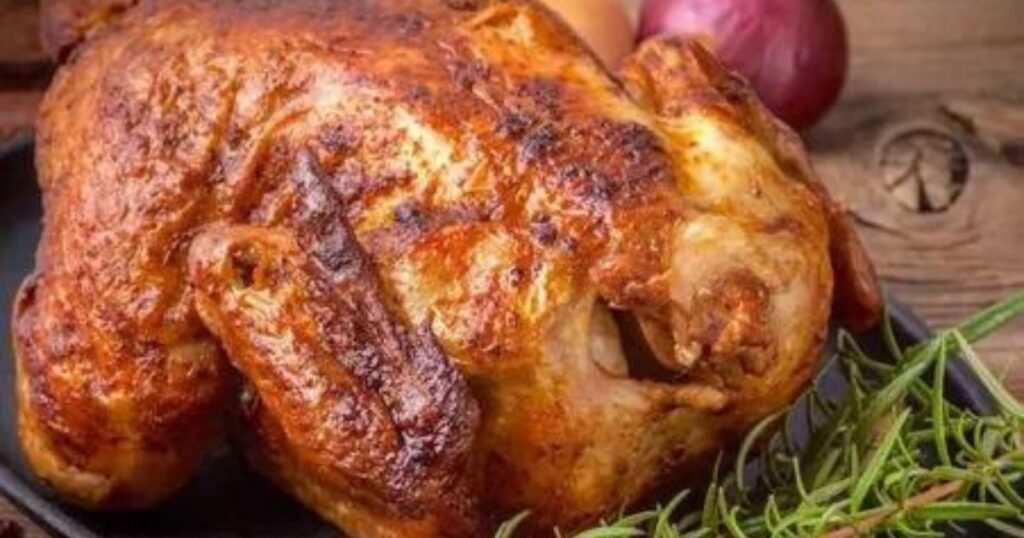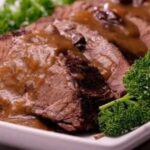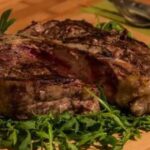Cooking a cross rib roast involves seasoning the meat with salt, pepper, and desired herbs, then roasting it in the oven at a temperature of 325°F (163°C) until it reaches an internal temperature of 145°F (63°C) for medium-rare or 160°F (71°C) for medium. Rest the Rib roast for 15-20 minutes before slicing against the grain for tender and flavorful results.
How to cook a cross rib roast? Let’s explore the simple steps and delightful flavours that await as we dive into the art of cooking this savoury dish with a touch of culinary expertise.
Cooking a cross rib roast is a simple yet rewarding culinary endeavour. Begin by preheating your oven to 325°F (163°C) and preparing the roast for seasoning. Generously rub the Rib roast with salt, pepper, and any preferred herbs or spices, ensuring even coverage for maximum flavour. Place the seasoned roast in a roasting pan, preferably on a rack to allow for even cooking.Roast the meat uncovered in the preheated oven, allowing it to cook for approximately 20 minutes per pound. It’s essential to monitor the internal temperature of the roast using a meat thermometer, aiming for 145°F (63°C) for medium-rare or 160°F (71°C) for medium doneness.
Selecting the Perfect Rib Roast

Selecting the perfect cross rib roast is essential for ensuring a successful cooking experience. When choosing your Rib roast, look for one with ample marbling throughout the meat. Marbling refers to the thin streaks of fat that run through the muscle tissue, and it plays a crucial role in keeping the roast juicy and tender during cooking. Additionally, seek out a Rib roast with a layer of fat on the outside. This outer fat not only adds flavour but also helps to protect the meat from drying out as it cooks.
Furthermore, consider the size and shape of the Rib roast. Opt for a Rib roast that is uniform in size and shape, as this will promote even cooking. Irregularly shaped Rib roasts may cook unevenly, resulting in portions that are overcooked or undercooked. Finally, if possible, choose a roast that has been aged for tenderness. Ageing allows the natural enzymes in the meat to break down connective tissue, resulting in a more tender and flavorful Rib roast. By selecting a well-marbled, properly sized, and ideally aged cross rib roast, you set the stage for a delicious dining experience.
Preparation
Preparation is the foundation of a successful cross rib roast cooking endeavour. Begin by ensuring that your Rib roast is at room temperature before it hits the oven. Allowing it to sit out for about 30 minutes helps relax the meat fibres, ensuring more even cooking throughout. Meanwhile, preheat your oven to 325°F (163°C), providing the ideal environment for slow roasting. As the oven heats up, take the opportunity to season your Rib roast generously.
A simple combination of kosher salt and freshly ground black pepper works wonders, but don’t hesitate to add your favourite herbs and spices for extra flavour. Rub the seasoning mixture onto the entire surface of the Rib roast, ensuring an even coating that will enhance the taste of every bite. This step sets the stage for a Rib roast that is not only tender and juicy but bursting with delicious flavours.
Seasoning
Seasoning is a crucial step in preparing a cross rib roast, as it infuses the meat with flavour and enhances its natural richness. Begin by generously coating the entire surface of the Rib roast with kosher salt and freshly ground black pepper. The coarse texture of kosher salt helps to create a flavorful crust while allowing the meat to retain its natural juices. Additionally, consider adding herbs and spices to elevate the flavour profile of the Rib roast.
Classic choices include garlic powder, rosemary, thyme, and oregano, but feel free to experiment with your favourite herbs and spices to suit your taste preferences. Rub the seasoning mixture evenly into the meat, ensuring that every inch is well-seasoned for a depth of flavour that permeates with every bite.
As you season the cross rib roast, consider incorporating complementary ingredients such as minced garlic or finely chopped shallots to add layers of complexity to the flavour profile. Rub these aromatics onto the surface of the meat along with the salt, pepper, and herbs, allowing them to infuse their essence into the Rib roast as it cooks. Additionally, a drizzle of olive oil or melted butter can help to seal in moisture and create a golden crust on the exterior of the Rib roast.
Whether you prefer a simple seasoning blend or a more elaborate herb and spice rub, the key is to ensure that each ingredient works in harmony to enhance the natural flavours of the beef, resulting in a Rib roast that is succulent, aromatic, and bursting with deliciousness.
Cooking
Cooking a cross rib roast is a culinary adventure that promises rich flavours and tender bites. Begin by selecting a high-quality roast with marbling and a layer of fat, ensuring succulence and flavour throughout. Preheat your oven to 325°F (163°C) and season the Rib roast generously with salt, pepper, and your favourite herbs and spices. Place it on a rack in a Rib roasting pan, fat side up, and insert a meat thermometer. Rib Roast the meat for approximately 20 minutes per pound until it reaches your desired level of doneness, whether it’s medium-rare at 145°F (63°C) or medium at 160°F (71°C). Don’t forget to baste the Rib roast periodically to keep it moist and flavorful.
Once cooked to perfection, remove the roast from the oven and let it rest for at least 15 minutes before carving. This resting period allows the juices to redistribute, resulting in a juicy and tender roast. Carve thin slices against the grain and serve alongside your favourite side dishes for a memorable meal that will leave your guests impressed. Whether it’s a special occasion or a cosy family dinner, mastering the art of cooking a cross roast will elevate your culinary skills and delight your taste buds with its irresistible flavour and texture.
Resting
Resting the cross rib roast is a crucial step that should not be overlooked. After removing the Rib roast from the oven, transfer it to a cutting board and tent it loosely with aluminium foil. This resting period allows the internal temperature of the meat to stabilise and the muscle fibres to relax, resulting in a juicier and more tender roast. Additionally, resting allows the juices within the roast to redistribute evenly throughout the meat, ensuring that each slice is flavorful and succulent.
While it may be tempting to carve into the roast immediately, resist the urge and allow it to rest for at least 15 minutes. This short waiting period can make a significant difference in the final outcome of your roast, as it allows the flavours to meld and intensify. Patience during this crucial stage will be rewarded with a cross rib roast that is moist, flavorful, and perfectly cooked from edge to edge.
Carving and Serving
Carving the cross rib roast is a crucial step to ensure optimal tenderness and presentation. Begin by locating the grain of the meat, which typically runs in one direction. Using a sharp carving knife, slice the roast against the grain into thin, even pieces. This technique helps break up the muscle fibres, resulting in more tender and enjoyable bites. As you carve, be mindful of any bones that may be present, and carefully navigate around them to create clean slices. Arrange the slices neatly on a serving platter, garnishing with fresh herbs for an added touch of elegance.
When it comes to serving the cross rib roast, consider pairing it with complimentary side dishes to create a well-rounded meal. Classic accompaniments such as roasted potatoes, steamed vegetables, or buttery dinner rolls all complement the rich flavours of the roast. Additionally, you may wish to offer a selection of sauces or gravies on the side, allowing guests to customise their dining experience. Whether it’s a festive celebration or a casual gathering, serving a beautifully carved cross rib roast is sure to be the highlight of the meal, bringing warmth and satisfaction to all who partake.
Faqs
What is the capital of France?
Paris.
How many continents are there?
Seven.
Who wrote “To Kill a Mockingbird”?
Harper Lee.
What is the chemical symbol for water?
H2O.
What year did the Titanic sink?
1912.
Conclusion
Frequently Asked Questions (FAQs) play a crucial role in various domains, including customer service, education, and information dissemination. By compiling common inquiries and providing concise yet comprehensive answers, FAQs serve to streamline communication and enhance user experience.
Not only do FAQs offer quick solutions to common problems or queries, but they also contribute to the efficiency of support systems and reduce the workload on customer service representatives. Additionally, FAQs can serve as valuable educational resources, helping individuals quickly grasp fundamental concepts or procedures without the need for extensive research.
click on this link to get more information “How To Cook Bear Meat?”


